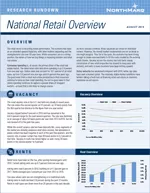Despite market challenges, retail properties receive steady financing interest
Remarkably, retail has been a consistent third-place performer for NorthMarq in terms of financing activity, trailing just multifamily and office. This has occurred despite the ongoing challenges related to store bankruptcies and e-commerce competition, and the questions related to the future of many major malls. So, what gives? What activity is there in the financing marketplace? Who are the lenders, and how do they view the markets?
The quick answer is that there are a multitude of sources for retail deals. But they shake out based on the type and location of the real estate, the credit of the tenancy, and the experience and wherewithal of the borrower. For example, life companies dominate activity in traditional grocery-anchored, stable, neighborhood centers; conversely, specialty finance companies and recourse-driven banks capitalize single-tenant retail in all types of market locations. A deeper dive can explain some of the reasoning behind the differentiation.

National Retail Overview
for details on the state of the retail market
Overall, retail vacancy has been quite steady over the past several years, dipping below 5% in 2016 and maintaining that course even now. On one hand, we are in the midst of an unprecedented economic expansion, with record lows in unemployment driving retail spending upward in a consumer-driven economy. On the other hand, retail is impacted greatly by consumer buying habits and e-commerce disruption, in which it is not unusual for many homes (and I include mine) to have package deliveries seemingly every day –and some days, multiple times. These conflicting trends have kept new construction from going overboard. Space deliveries, which averaged 70 million sq. ft. annually in 2015-2017, dropped to 60 million sq. ft. in 2018 and will continue their downward trend. Thus, with supply in check, lenders are able to finance leased retail, so long as it exhibits some staying power.
LENDER PERSPECTIVE ON RETAIL PROPERTY TYPES
Regional Malls: Major bifurcation exists between Class A REIT-owned and Class B centers seemingly on the edge of survival and failure. Naturally, one (Class A) has multiple sources of institutional financing and the other struggles to find lenders. Those who venture there often underwrite underlying land value, have recourse from a strong sponsor, or look at a combination of both, with interest rates trending higher. High-end “Main Street” lifestyle centers are the new Class A mall, with high-dollar values and life companies, big banks, and Wall Street CMBS in the financing mix.
Grocery-Anchored Neighborhood Centers get the most competitive lending terms. Infill centers driven by strong demographics are a focus for life companies up to 65-70% loan-to-value (LTV). Higher LTV can be underwritten competitively by CMBS lenders. Even centers with less desirable demographics can garner decent debt if the anchor is credit-worthy and the center has a history of high occupancy. Such neighborhood centers are viewed as convenient to the consumer, and even if the groceries are delivered, they are sourced at the neighborhood store.
Single-Tenant Retail (drug stores, banks, restaurants) is largely credit dependent but has been a very active new construction and financing market as leading retailers have been active in this space in the growing economy. Select life companies who focus on this type of property do a fair share of it on a long-term, fixed-rate basis, whereas many other life companies simply shy away from all types of single-tenant retail. Banks and credit unions are very active in this space, supplemented by recourse where needed. The name of the retailer and the type of building constructed matter quite a bit. Unanchored strip retail – while different from a single-tenant pad –is covered by this same lender mix.
Big Box Retail is the one “hot” category that has gone “cold,” but it’s not without lenders unless the center overall is struggling. We find that CMBS is the best source for larger centers, as life companies can be quite particular and conservative. Still, for the best demographic locations, life companies may be the best choice. One of the most significant challenges of big box is the credit worthiness of the retailers, as this space is facing e-commerce competition. And once a vacancy exists, the new generation retailer may not demand the same size of the former large-footprint store. This leads to pretty meticulous underwriting.
Redevelopment: Lastly, while ground-up development is slow, redevelopment activity is strong and increasing. As retail shifts from consumer product sales towards services, including local delivery and food sales, infill centers are in need of redevelopment at an increased rate. This has led to an active “bridge debt” market.
Bridge debt funds are best for non-recourse, as they desire a shorter term (three years) and look to be refinanced when renovation is complete. The good news for borrowers is that rates have come way down in this space as a lot of capital is flowing into the debt fund arena.
NorthMarq is in the market every day, with every one of these capital sources and with each of these property types. We are happy to field your questions and help serve your financing needs.
Northmarq is a full-service capital markets resource for commercial real estate investors, offering seamless collaboration with top experts in debt, equity, investment sales, loan servicing, and fund management. The company combines industry-leading capabilities with a flexible structure, enabling its national team of experienced professionals to create innovative solutions for clients. Northmarq's solid foundation and entrepreneurial approach have built an annual transaction volume of more than $39 billion and a loan servicing portfolio of more than $76 billion. Through the 2022 acquisition of Stan Johnson Company and Four Pillars Capital Markets, Northmarq established itself as a provider of opportunities across all major asset classes. For more information, visit: www.northmarq.com.
